
La Fortaleza, also known as Palacio de Santa Catalina, has been the official residence of the governor of Puerto Rico since the 16th century, making it the oldest executive mansion in continuous use in the New World. Built between 1533 and 1540 by orders of Charles I of Spain, the structure was the first fortification constructed by the Spanish on San Juan Islet to defend San Juan Bay, the harbor of Old San Juan. La fortaleza, alongside El Morro, San Cristóbal, El Cañuelo, and other forts part of the Walls of Old San Juan, protected strategically and militarily important Puerto Rico, or La Llave de las Indias , from invasion by competing world powers and harassment by privateers and pirates during the Age of Sail. It was designated a World Heritage Site by UNESCO in 1983 as part of La Fortaleza and San Juan National Historic Site.

Old San Juan is a historic district located at the "northwest triangle" of the islet of San Juan in San Juan. Its area roughly correlates to the Ballajá, Catedral, Marina, Mercado, San Cristóbal, and San Francisco sub-barrios (sub-districts) of barrio San Juan Antiguo in the municipality of San Juan, Puerto Rico. Old San Juan is the oldest settlement within Puerto Rico and the historic colonial district of the city of San Juan. This historic district is a Puerto Rico Registered Historic Zone and a National Historic Landmark District named Zona Histórica de San Juan and is listed on the United States National Register of Historic Places as the Old San Juan Historic District. Several historical buildings and structures, particularly La Fortaleza, the city walls, and El Morro and San Cristóbal castles, have been inscribed in the UNESCO World Heritage Site list since 1983. Historically the mixed-use commercial and residential real estate in the main streets of Calle Cristo and Calle Fortaleza from Calle Tanca to the Governor’s Mansion is the most valuable in the area and it has kept its value and increased steadily through several years despite the past economic turmoils.

San Juan National Historic Site in the Old San Juan section of San Juan, Puerto Rico, is a National Park Service-managed historic site which preserves and interprets the Spanish colonial-era fortification system of the city of San Juan, and features structures such as the San Felipe del Morro and San Cristóbal fortresses. This fortification system is the oldest European construction under United States jurisdiction and one of the oldest in the New World. This national historic site, together with La Fortaleza, have been designated a UNESCO World Heritage Site since 1983.

Miramar is one of the forty subbarrios of Santurce, San Juan, Puerto Rico. The neighborhood has many historic Spanish Revival-style homes with patios and gardens, and it was listed on the Puerto Rico Register of Historic Sites and Zones in 2007 for its historical and architectural value.
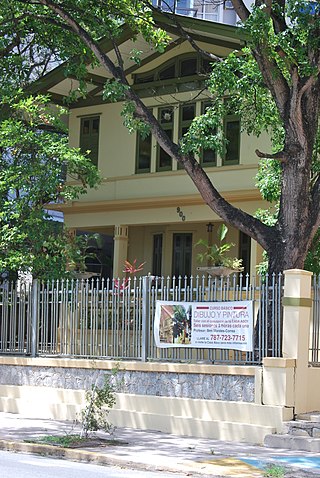
The Aboy-Lompré Residence, also known as the Aboy House, is a historic house built in San Juan, Puerto Rico between 1910 and 1912 for the Aboy-Ferrer Family. The house now hosts several cultural and religious institutions including the Shaare Zedeck Synagogue and the Jewish Community Center of Puerto Rico, and a photojournalism museum.
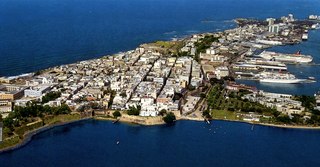
San Juan Islet is a 3-square-mile (7.8 km2) islet or small island on San Juan Bay in the Atlantic coast of northern Puerto Rico. Home to Old San Juan, it is the site of the oldest permanent European settlement in Puerto Rico (1521), and the second oldest European settlement in the West Indies after Santo Domingo (1496). Due to its strategic location in the Caribbean during the Spanish colonization of the Americas, it is home to a city wall and a number of militaristic buildings such as El Morro Castle. Today, it is also home to many of Puerto Rico's government buildings such as the territory's capitol building.
The 1918 San Fermín earthquake, also known as the Puerto Rico earthquake of 1918, struck the island of Puerto Rico at on October 11. The earthquake measured 7.1 on the moment magnitude scale and IX (Violent) on the Mercalli intensity scale. The mainshock epicenter occurred off the northwestern coast of the island, somewhere along the Puerto Rico Trench.

Edificio Oliver in Arecibo, Puerto Rico was built in 1914. The building houses government offices for the municipality of Arecibo.

This is a list of properties and districts in the western municipalities of Puerto Rico that are listed on the National Register of Historic Places. It includes places along the western coast, and on islands, and on the western slope of Puerto Rico's Cordillera Central.

Ponce Cement, Inc. was a cement and limestone manufacturer in Ponce, Puerto Rico. The company was located at the intersection of PR-123 and PR-500, in Barrio Magueyes. It was founded in 1941 by Antonio Ferré Bacallao, a Puerto Rican industrialist of Cuban origin. In 1963, the company became the first Puerto Rican company to go public and be listed in the New York Stock Exchange.

The Antiguo Cuartel Militar Español de Ponce or "El Castillo" is the only structure directly related to the events of the land defense of Puerto Rico during the 1898 American invasion of the Island. The historic building dates from 1894 and is located on Calle Castillo in Ponce, Puerto Rico, in the city's historic district. The structure was listed on the U.S. National Register of Historic Places on 14 May 1987.

The Rosaly–Batiz House is a historic building located on Villa street in Barrio Primero in Ponce, Puerto Rico, in the city's historic district. The building dates from 1897. It was designed by Manuel V. Domenech, a Puerto Rican architect that was responsible for designing various other now-historic buildings. Domenech built this residence for Ponce mayor Pedro Juan Rosaly. Domenech himself became mayor of Ponce and held numerous other political positions in Puerto Rico. The Batiz Residence is a monument to a great man and his works and a vivid reminder of the aristocracy of the years prior to the Great Depression.

Casa Font-Ubides, also known as the Residencia Monsanto is a historic building located on the north side of Castillo Street in Ponce, Puerto Rico, in the city's historic district. The building dates from 1913. It was designed by the architect Blas Silva. The architecture consists of 19th Classical revival and Art Nouveau architectural styles. The building is of architectural significance for its aggressive incorporation of curvilinear forms and ornaments. The complete preservation of the original architecture of the Monsanto Residence, its unique design amongst the houses of Ponce, and its location within the historic urban core of the city qualify it as one of a series of grand houses and an integral part of the character of Ponce.

La Fortaleza and San Juan National Historic Site in Puerto Rico is a UNESCO World Heritage Site located in Puerto Rico, an unincorporated territory of the United States in the Caribbean. The world heritage site consists of several historic defensive structures built by the Spanish Empire between the 16th and 20th centuries to defend the strategically located colonial city of San Juan and its bay from foreign attacks. These fortifications are among the oldest European-built defensive systems and largest of its kind in the Western Hemisphere. In addition to its historic importance the site is notable for its architectural significance as one of the most prominent military adaptations of Renaissance and Baroque architecture in the Americas.

The Gay Pride Community Building, also known as Casa Orgullo, is a historic site and former LGBT community center located in Río Piedras Pueblo in San Juan, Puerto Rico.
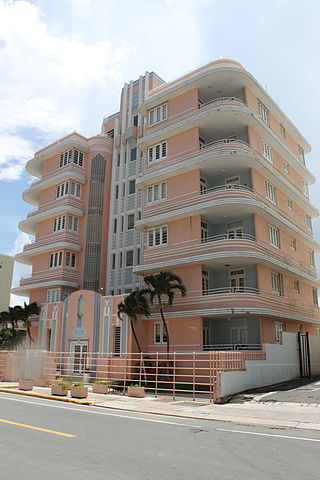
The Miami Building, also known as the Miami Apartments or the 868 Ashford Building, is a historic Art Deco building located in the Avenida Ashford of the Condado section of Santurce in the city of San Juan, Puerto Rico. The building was added to the National Register of Historic Places in 1984 and to the Puerto Rico Register of Historic Sites and Zones in 1995.

The United States Custom House, also known as the San Juan Custom House, is a historic custom house located at the marina of Old San Juan in the city of San Juan, Puerto Rico. The custom house is located at the site of the former main port of the city of San Juan, north of the former Spanish Arsenal of San Juan, and next to the Las Dársenas and Immigrants' Square and the Jose V. Toledo Federal Building and United States Courthouse. The large two-storey custom house is considered by the NRHP to be a superb example of Spanish Colonial Revival architecture in Puerto Rico and the Caribbean. It is most notable for its size, its elaborate terracotta-ornamented central tower and its pink-colored exterior.
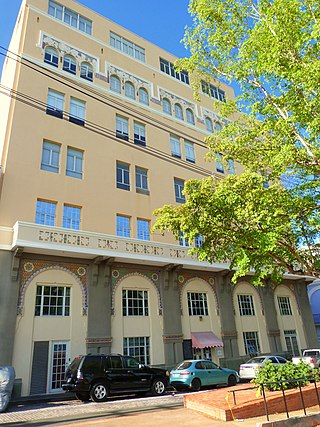
Puerto Rico Ilustrado/El Mundo Building is a historic Art Deco high-rise building located in the Old San Juan historic district of the city of San Juan, Puerto Rico. The building was erected in 1923 to serve as the headquarters of the El Mundo newspaper and the Puerto Rico Ilustrado magazine. The architecture of the building blends numerous styles that represent the conjunction of various artistic movements and architectural schools of the late 19th century and the early 20th century. It is located in a high-rise block that faces the elevated La Palma Bastion portion of the city wall of San Juan which, when observed from beyond, makes the building look taller than it is in reality. The building was added to the National Register of Historic Places in 1997 for its architectural and historic importance.
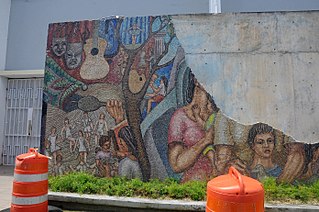
La Familia is the name of a mural by Puerto Rican muralist Rafael Ríos Rey located in the Barrio Obrero Community Center in Santurce, in the city of San Juan, Puerto Rico. The mural depicts various scenes from the history of Puerto Rico with references to the popular culture, arts and folklore of the island. The centerpiece of the mural is a traditional working-class family, the namesake of the artwork. La Familia was commissioned by the municipal government of San Juan for the exterior of the newly built community center at Barrio Obrero, a working-class neighborhood of Santurce. The mural was greatly affected by Hurricane Maria in 2017. That same year it was added to the National Register of Historic Places (NRHP) in 2017 where it is described as a superb example of Venetian mosaics art form in Puerto Rico and as one of the most influential works of art created by Rafael Ríos Rey. Other murals also created by Ríos Rey located in the Ponce YMCA and Edificio Empresas Ferré have also been distinguished by the National Park Service and listed into the NRHP.


















